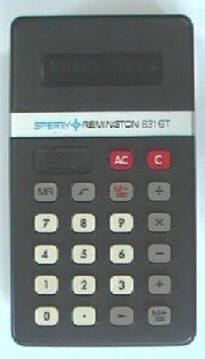

The Sperry Remington 831-GT calculator has an eight-digit green flourescent display and is powered by a four AA batteries. It has a textured black top case, with a silver stripe between the display and keyboard that has the Sperry Remington logo and model number. The main body of the machine is a heavy, off-white plastic. The label on the rear of the machine indicates that it was made in Japan,its power consumption is 0.23 Watts, and specifies AC Adaptor model AD-4145 for the adapter jack located at the top left of the machine.
The machine has a three-position switch, marked OFF ON M. The function keys are: (red keys) AC, C, (gray keys) MR, sq. root, M-=, divide, X, -, +, M+=, and a right- arrow. The numeric keys and decimal point are white. It uses standard algebraic logic. The AC key clears the machine, pending operations, and memory. The C key, if pressed once, clears the last number entered, if pressed twice, clears the machine but not the memory. An interesting characteristic of the machine during calculations is that it does not blank or freeze its display - the digit segments spin around. In the case of square root, this is easily visible because the calculation takes almost a full second.
Memory is controlled by a combination of the switch position and the MR, M-=, and M+= keys. When the switch is set to M, the machine adds/ subtracts from memory the result of a calculation ended by the M+= or M-= key. The MR key recalls the current memory value to the display for further use. If the switch is set to the ON position, the M+= and M-= keys simply act as an = key, and no change is made to the memory. Any value that was in memory when the switch was moved from M to ON remains in memory for use unless the AC key is pressed.
Like many other of the Sperry-Remington and some of the Casio models, this calculator has the capability to display 16-digit answers, using the right-arrow key. If a problem is entered that overflows the 8-digits of the display, the decimal point disappears, with the upper 8 significant digits of the answer displayed. Pressing the right- arrow key reveals the lower 8 significant digits including the proper decimal point position. The answer cannot be used in subsequent calculations, however, because the machine locks up and the AC key must be used to clear the overflow condition. In the case of a negative number, only seven significant digits are displayed, with the leftmost digit used for the minus sign.
It appears to me that this calculator was built for Sperry Remington by Casio. One similar characteristic between this machine and a number of Casio machines is that the number "0" is displayed using only the lower four segments of the seven-segment display. This has the unusual effect of having the height of numbers appear differently across the display. Secondly, the design of the keys appears to be the same of the Casio Mini.